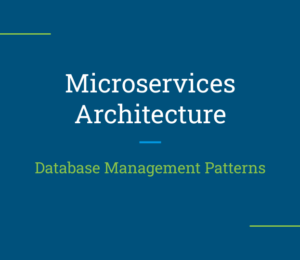Patterns For The Design Of Microservices – Part 3
- November 16, 2023
- 4304 Unique Views
- 5 min read
In part1, part2, we discussed several design patterns that aid in the development of microservices.
This blog post will cover the subsequent design patterns.
- Observability Patterns
- Cross-cutting Concern Patterns
 Microservice Architecture Patterns
Microservice Architecture Patterns
Observability Patterns
Undoubtedly, the logging mechanism benefits troubleshooting issues that arise when executing operations or transactions on multiple deployed microservices.
We can further categorize the observability patterns into six distinct patterns.
- Log Aggregation
- Application Metrics
- Audit Logging
- Distrubuted Tracing
- Exception Tracking
- Health Check API
In the subsequent segment, we will discuss each topic separately.
Log Aggregation
By implementing the microservice architecture pattern, we partition the monolithic application into several microservices and deploy them separately. Nevertheless, we need to establish a centralized logging mechanism across all the services to ensure seamless communication between them. This approach facilitates developers in tracing and troubleshoot issues that may arise during the application's operation.
The centralized logging file must encompass error, warning, information, and debug messages, and it should consolidate all logs from various service instances. And, upon detecting specific occurrences in the logs, we can activate alert mechanisms.
The following services commonly employ capturing and storing logs in applications built on microservice architecture:
Props
To capture all the logs, we need substantial infrastructure.
Application Metrics
Gaining a comprehensive understanding of the application's performance through the observation of metrics captured throughout its runtime is crucial.
The application shall record and transmit all metrics to a centralized server for safekeeping. Later, we will obtain the metrics from the server to conduct a thorough analysis.
A plethora of instrumentation and metric libraries and tools for capturing application metrics.
We can use tools such as Prometheus, Grafana, AWS CloudWatch, and Azure Monitoring to assist in consolidating the metric.
We can also use instrumentation libraries such as Prometheus Client Libraries and Coda Hale/Yammer Java Metrics Library
Audit Logging
The user needs to capture and store different events while interacting with various instances of microservices in the database. The microservice architecture extensively employs this practice, commonly referred to as audit logging.
Distrubuted Tracing
Microservices architectures employ distributed tracing as a crucial technique for monitoring and resolving intricate, distributed systems. It helps in comprehending and visually representing the progression of requests as they navigate through diverse microservices and components, thereby offering valuable insights into the system's performance and behavior. This technique plays a vital role in identifying problems, enhancing performance, and guaranteeing dependability within a microservices environment.
Utilizing the Spring Boot and Spring Cloud, Micrometer frameworks as a Microservice chassis achieves distributed tracing. They offer various capabilities, including Spring Cloud Sleuth and Micrometer. This feature facilitates distributed tracing by instrumenting Spring components to collect trace information and deliver it to a Zipkin Server, Prometheus, or Grafana. These services then gathers and presents the traces.
In the context of event-driven architecture, we employ Message Queue systems such as ActiveMQ, RabbitMQ, or Kafka to capture traces and subsequently transmit them to Monitoring Servers.
Exception Tracking
In the microservices architecture, separate servers host numerous services and instances. If a runtime issue occurs, the application raises an exception and provides a stacktrace to indicate how it manages the exception.
To optimize code and ensure cleanliness, developers commonly practice writing single exception handling (@RestControllerAdvice) class for the entire application instead of writing it for each individual module.
Health Check API
In the microservice architecture, a service may be incapable of processing a request despite the application being operational, owing to connectivity problems with databases, messaging systems, or other issues. In such cases, users cannot execute any requests and must activate an alert mechanism.
In the Spring Boot framework, we can validate the application's health by utilizing the spring-boot-starter-actuator dependency. The Spring Boot Actuator module creates an /health endpoint, which captures various metrics that aid developers in regularly monitoring the application.
Cross-cutting Concern Patterns
We can further categorize the cross-cutting concern patterns into four distinct patterns.
- External Configuration
- Service Discovery Pattern
- Circuit Breaker Pattern
- Blue Green Deployment Pattern
External Configuration
In a monolithic application, the application tightly couples the majority of the business-related properties, database, or any 3rd party related services.
Nevertheless, in a microservice architecture, we can externalize these configurations by utilizing Github for the development, testing, and production environments.
As a result, this approach enables developers to effortlessly modify or enables profiles and business-related properties without the need for deployment.
Spring Boot's externalized configuration makes values within the Spring application context accessible. It retrieves them from various sources such as operating system environment variables, property files, and command line arguments.
Service Discovery Pattern
In monolithic architecture, a fixed host and port number are used for service communication, utilizing protocols such as REST API and Remote Procedure Calls (RPC).
However, in microservice architecture, applications typically operate within virtualized or containerized environments, resulting in dynamic changes to the number and locations of service instances. Applications employ HTTP/REST protocols to invoke these services.
The Service Discovery pattern has two categories:
Client-side Service Discovery
This approach involves registering all service instances in the discovery server as soon as the service is up and running. Conversely, the instances are de-registered when the service is stopped or shutdown. This implementation resembles a HashMap and does not involve a load-balancer to handle requests.
Server-side Service Discovery
Similar to client-side service discovery, this method registers all service instances in the discovery server upon their activation. Likewise, the instances are de-registered when the service is stopped or shutdown. However, in this scenario, a load-balancer is present to manage incoming requests.
In the realm of Microservices, numerous frameworks and components enable the execution of the service discovery pattern. These include Netflix OSS Components, OpenFeign Kubernetes, Istio, Consul, and several others.
The Netflix OSS Components offer Eureka, a Service Registry, and Ribbon to facilitate communication between services. However, OpenFeign has now substituted Eureka, serving as an abstraction of both the Service Registry and Ribbon.
We will utilize the application name to invoke a service from another. The service registry maintains multiple instances of services, each with dynamically assigned IP addresses and ports. Therefore, by specifying the application name, we can successfully invoke the desired service.
Circuit Breaker Pattern
In certain cases, services may encounter unanticipated failures or undergo maintenance, resulting in the user experiencing unresponsiveness while utilizing them. To enhance the customer/user experience, we will incorporate a circuit-breaker pattern and establish a fallback method that ensures a seamless user journey without causing any inconvenience.
Utilizing Netflix Hystrix in conjunction with Spring Boot enables us to address latency and fault tolerance, achieving the implementation of this pattern. However, it is important to note that the approach is currently in maintenance mode and no longer supports any further enhancements.
To enhance modularity, we have introduced a new framework called Resilience4j. This framework segregates Circuit Breaker, Rate Limiter, Retry, and Bulkhead into separate modules, allowing for greater flexibility and customization.
Blue-Green Deployment Pattern
In microservice architecture, we employ the technique of blue-green deployment to securely update and launch software applications without any interruptions or disturbances. To put it simply, you can envision having two identical sets of your application, with one labeled "blue" and the other labeled "green."
The process operates as follows:
Blue Deployment
Customers are already utilizing the current and operational application, and this pattern will enhance any new features for it.
Green Deployment
This is the updated version of your application that you desire to deploy and evaluate.
Reference
Don’t Forget to Share This Post!










Comments (0)
No comments yet. Be the first.